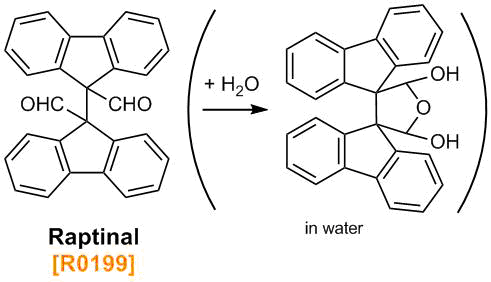Published TCIMAIL newest issue No.197
Maximum quantity allowed is 999
Please select the quantity
Professor Paul J. Hergenrother identified and prepared Raptinal, a small molecule that induces apoptotic cell death at unparalleled speed via the intrinsic pathway, a process that typically takes hours. Additionally, Raptinal shows tumor growth inhibition in vivo. This impressive and unmatched activity lends Raptinal to many applications in biology, pharmacology, and chemistry.

Advantages
• Rapid apoptosis induction (minutes) - faster than staurosporines.
• Induces cell apoptosis via the caspase-dependent intrinsic pathway.
• IC50 of few micromolar across 22 cell lines after 24 h of incubation.
• Critical roles of mitochondrial processes to apoptotic induction.
• Tumor inhibition activity in vivo in zebrafish embryos and mice.
• Non-light sensitive and easy to handle.
• Induces cell apoptosis via the caspase-dependent intrinsic pathway.
• IC50 of few micromolar across 22 cell lines after 24 h of incubation.
• Critical roles of mitochondrial processes to apoptotic induction.
• Tumor inhibition activity in vivo in zebrafish embryos and mice.
• Non-light sensitive and easy to handle.
Work conducted by the Hergenrother research group at UIUC has shown raptinal to be a superior inductor of cell apoptosis, often outperforming the gold standard apoptosis inducer saurosporine. Recent gene knockdown experiments suggest that raptinal's mechanism of action resides in the intrinsic pathway, making raptinal an ideal research tool for probing the ubiquitous cell process. raptinal is bench stable, non-light sensitive, easy to handle, and can be a valuable research tool for understanding apoptosis, mitochondrial pathways, drug discovery, and anti-tumor research.
Activity Comparison and Assay of Raptinal

Fig. 1 Raptinal shows significantly accelerated apoptotic cell death compared to other
apoptotic compounds such as Staurosporine and Camptothecin.

Fig. 2 Capsase-3/7 assay of raptinal vs. siRNA sequences.
References
- 1)A Small Molecule that Induces Intrinsic Pathway Apoptosis with Unparalleled Speed
- 2)The Inflammasome Drives GSDMD-Independent Secondary Pyroptosis and IL-1 Release in the Absence of Caspase-1 Protease Activity
- 3)Oxidation of Atg3 and Atg7 mediates inhibition of autophagy


